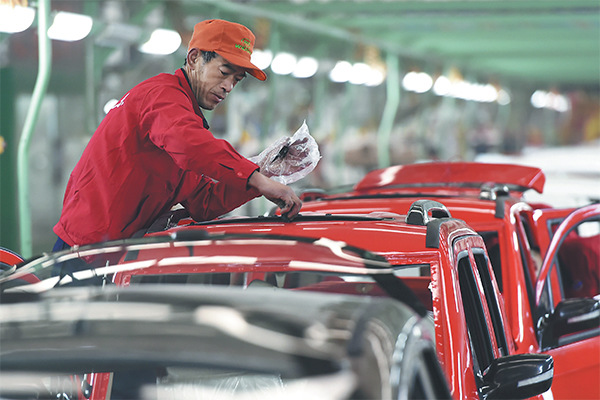
A worker works on electric cars at a plant in Zouping county, Shandong province. The fast-growing new energy vehicle sector now faces the risk of overcapacity. (Photo/Xinhua)
Companies chasing new energy vehicle profits could crowd each other out
China's fledging new energy vehicle sector is confronted with the risk of severe overcapacity as traditional automakers and fresh faces are rushing to exploit the segment that is believed to be the largest gold mine of the automotive industry.
On Tuesday, Wanxiang Group won the nod from the authorities for its plant in Zhejiang province, which will be able to produce 50,000 electric cars per year when completed.
The move made the giant auto parts supplier the sixth company approved to jump on the wagon of electric car making in China this year.
The six newcomers' annual capacity will reach a combined 1.13 million units per year around 2020.
The figure exceeds 2 million units when coupled with those from NextEV, Chehejia and LeEco, all dotcom companies.
Traditional automakers have even more ambitious plans. Public statistics show that the combined annual capacity of 13 major passenger carmakers including BYD, SAIC Motor and JAC Motor will exceed 4 million units by 2020.
That means China will be able to produce about 7 million new energy vehicles a year by the end of the decade, more than three times the goal the country has set: 2 million units sold annually in 2020.
The simple math shows plants with a combined capacity of around 5 million units will stand idle even if China manages to fulfill the ambitious target, and some suggest an even worse scenario as the goal would be difficult to achieve considering the sector's current performance.
China sold 400,000 new energy vehicles from January to November this year for year-on-year growth of 60 percent, according to statistics from the China Association of Automobile Manufacturers.
Such vehicles are defined in China to consist of electric cars, plug-in hybrids and fuel cell cars but exclude hybrids like Toyota's Prius.
Despite a growth rate much faster than that of the industry's average of around 13 percent, Wang Binggang, an expert on China's new energy vehicles program, said: "It is mainly driven by government policies instead of market demand."
The central government offers a subsidy up to 55,000 yuan ($7,913) for an electric passenger car, 30,000 for a plug-in hybrid, and 500,000 yuan for an electric bus. Subsidies from local governments vary regionally.
The central government started offering subsidies in 2009 to stimulate the development of new energy vehicles.
By the end of last year, 33.4 billion yuan had been earmarked, according to the finance ministry.
But recently, things have started to change.
On Tuesday, the Ministry of Industry and Information Technology said the authorities will cut subsidies and totally withdraw them in four years now that some carmakers have been caught swindling the subsidies.
Ye Shengji, a CAAM deputy secretary-general, said the scheme was adjusted to ensure the steady and healthy development of the sector as it has grown rapidly in the past several years.


















































